There is a Chris Buchner identified as Ensign 3rd Regiment Lincoln Militia in Soldiers of the King, along with various other Buchner’s serving as Captain, Lieutenant and Privates.
Christopher Buchner
David Bastedo
2nd Regiment Lincoln Militia
David Tice Bastedo is the son of Jacob Bastedo UE and Clarissa Jean Van Slyke. David was born on 12 Mar 1769 near Schenectady, NY. During the American Revolution and while still a teenager David joined his uncle, Capt Gilbert Tice, at Fort Niagara and later Newark where he served as a scout with Butler’s Rangers during the last year of the war.
Following the war he married Elizabeth McMicking, daughter of Peter McMicking UE and settled at Stamford, Ont. David joined the 2nd Regiment Lincoln Militia and served as an Ensign until his promotion to Lt by Pres Andrew Grant in May of 1806.
John Kelly1st Flank Company5th Regiment Lincoln Militia
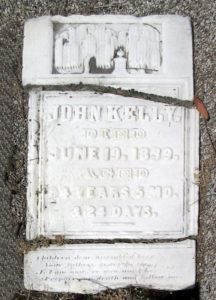 John was born about 1775, to Jonathan Kelly and Elizabeth Shaver. He died 19 Jun 1839, and is buried at Bowman United Church Cemetery in Ancaster Twp. During the War of 1812, John Kelly served as a Private, in the 5th Regiment Lincoln Militia.
John was born about 1775, to Jonathan Kelly and Elizabeth Shaver. He died 19 Jun 1839, and is buried at Bowman United Church Cemetery in Ancaster Twp. During the War of 1812, John Kelly served as a Private, in the 5th Regiment Lincoln Militia.
Continue reading John Kelly1st Flank Company5th Regiment Lincoln Militia
Henry Hagle Jr
5th Regiment Lincoln Militia
Henry Jr was born in Ancaster, Ontario, Canada 16 November 1795 and died 19 October 1836. He was the son of Henry Hagle Sr 1753-1834 and Hannah Christina Miner 1762-1826.
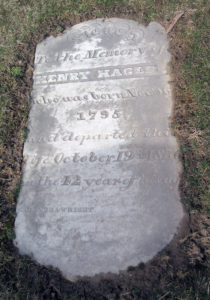 Henry along with his brother Luke and father fought in the 5th Regiment Lincoln Militia.
Henry along with his brother Luke and father fought in the 5th Regiment Lincoln Militia.
Henry’s father, Henry Sr settled at Ancaster in the spring of 1795, and later bought Lot 50 Conc 4 Ancaster from Jacob Bowman.
They heard from their father, Henry Hagle (1753-1834), that the Hagle family, after the reformation, had moved from Wurttemberg, a State in southern Germany, north to Hanover. When the agents of William Penn scoured Europe for Yeomen and tradesman to settle the State of Pennsylvania in the early 1700’s, one Henry Hagle, at the age of 14, came to America and lived for a while in Philadelphia. He had several children who where raised in New Jersey. During the American Revolution, a son, Jasper, while a prisoner-of-war at Valley Forge was poisoned by the rebels, so it was said.
Luke Hagle
5th Regiment Lincoln Militia
Luke was born in Ancaster, Ontario, Canada, 30 Nov 1796. He died 8 Apr 1845 in Ancaster, Ontario, and is buried in Bowman Cemetery, with his father and brother.
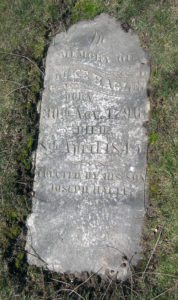 Luke married 31 Oct 1837 to Ellen Ralston.
Luke married 31 Oct 1837 to Ellen Ralston.
Luke along with his brother, Henry Jr and his father, Henry Sr fought in the 5th Regiment Lincoln Militia.
Luke’s father, Henry, settled at Ancaster in the spring of 1795 and later bought Lot 50 Conc 4 Ancaster from Jacob Bowman.
Henry Lewis Smith
2nd Flank Company
5th Regiment Lincoln Militia
Private Henry Lewis Smith
 Henry Lewis Smith was born 28 Jul 1786, in Sussex County, New Jersey, and died 18 Apr 1859. He married in 1808 Elizabeth Vandecar, daughter of Alexander Vandecar, United Empire Loyalist, born 11 Apr 1789, died 11 Mar 1863. His family had been members of the New Jersey Volunteers, and had served consistently for the British during the American Revolution. Henry died April 1859 in his 72nd year.
Henry Lewis Smith was born 28 Jul 1786, in Sussex County, New Jersey, and died 18 Apr 1859. He married in 1808 Elizabeth Vandecar, daughter of Alexander Vandecar, United Empire Loyalist, born 11 Apr 1789, died 11 Mar 1863. His family had been members of the New Jersey Volunteers, and had served consistently for the British during the American Revolution. Henry died April 1859 in his 72nd year.
Continue reading Henry Lewis Smith
2nd Flank Company
5th Regiment Lincoln Militia
Benjamin Smith
5th Regiment Lincoln Militia
Lewis B Smith
2nd Regiment Lincoln Artillery
Gunner Lewis B. Smith
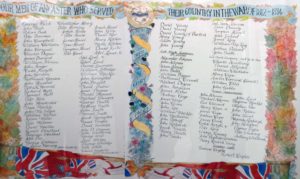 Lewis B Smith born 10 Jun 1764 in Amwell, Sussex, New Jersey, USA and his wife Phoebe Huffman born 30 Sep 1772 , married in 1785, at Johnsonburg, New Jersey, U.S.A. Shortly there after, they headed to Upper Canada to escape persecution.
Lewis B Smith born 10 Jun 1764 in Amwell, Sussex, New Jersey, USA and his wife Phoebe Huffman born 30 Sep 1772 , married in 1785, at Johnsonburg, New Jersey, U.S.A. Shortly there after, they headed to Upper Canada to escape persecution.
Continue reading Lewis B Smith
2nd Regiment Lincoln Artillery
John ‘Little John’ Smith
5th Regiment Lincoln Militia
John H. Smith
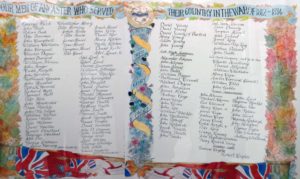 Captain Little John John Smith was born at Ludgate Hill, New Jersey, USA 13 Nov 1747 – 4 Aug 1846 , he was known as Little John as there were two John Smiths that came up at the same time.
Captain Little John John Smith was born at Ludgate Hill, New Jersey, USA 13 Nov 1747 – 4 Aug 1846 , he was known as Little John as there were two John Smiths that came up at the same time.
Continue reading John ‘Little John’ Smith
5th Regiment Lincoln Militia
Peter Bowman
5th Regiment Lincoln Militia
Captain Peter Bowman
 He was a Private in Butler’s Rangers from Susquehanna River. Enlisted at the age of 15 at Niagara July 1784. Took the oath of allegiance at Niagara sometime between Nov 1784 and Jun 1785. Listed as a settler “at the Mountain and near Fort Erie, 1785”. Land entitlement in the District of Nassau in 1792 totalled 350 acres. Captain in the 4th Regiment of the Lincoln Militia in 1811. Settled in Ancaster Township, Upper Canada. Died 28 Oct 1847 at the residence of his only surviving child, Mrs. P. Spohn, in Ancaster in An Annotated Nominal Roll of Butler’s Rangers 1777 – 1784, pg 50.
He was a Private in Butler’s Rangers from Susquehanna River. Enlisted at the age of 15 at Niagara July 1784. Took the oath of allegiance at Niagara sometime between Nov 1784 and Jun 1785. Listed as a settler “at the Mountain and near Fort Erie, 1785”. Land entitlement in the District of Nassau in 1792 totalled 350 acres. Captain in the 4th Regiment of the Lincoln Militia in 1811. Settled in Ancaster Township, Upper Canada. Died 28 Oct 1847 at the residence of his only surviving child, Mrs. P. Spohn, in Ancaster in An Annotated Nominal Roll of Butler’s Rangers 1777 – 1784, pg 50.

